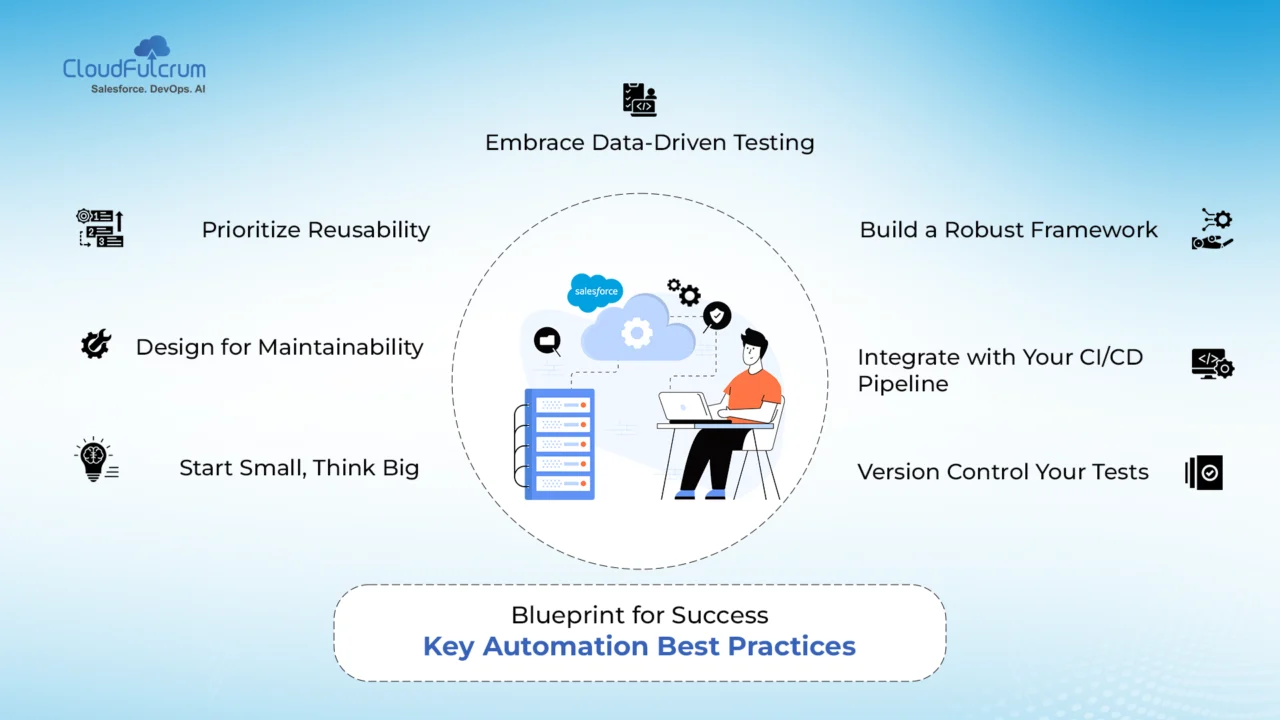In our last post, “Beyond Clicks: Unlocking Salesforce Automation ROI,” we made a compelling case for why test automation isn’t just a technical luxury for your Salesforce environment, but a strategic business imperative. We explored how it accelerates releases, cuts long-term costs, boosts deployment confidence, and ultimately enhances overall quality. Now, with the “why” firmly established, it’s time to tackle the “how.”
This third installment of “Mastering Salesforce Quality: A Strategic Blueprint” will guide you through the practical considerations of implementing effective Salesforce test automation. We’ll demystify the process, highlight key best practices, and explore the landscape of tools available to help you build a robust, maintainable, and scalable automation framework. The goal here isn’t just to automate tests, but to automate them well, ensuring they deliver consistent value over time.
Choosing Your Weapons: Navigating the Salesforce Test Automation Tool Landscape
The first major decision on your automation journey is selecting the right tools. The Salesforce ecosystem, while unique, offers a diverse range of options, from generic web automation frameworks to specialized Salesforce-centric platforms. Your choice will depend on factors like your team’s existing skill set, budget, the complexity of your Salesforce instance, and your integration needs.
Here’s a breakdown of common categories and examples:
- Open-Source Web Automation Frameworks (e.g., Selenium, Playwright, Cypress):
-
- What they are: These are powerful, flexible, and free-to-use tools designed for automating web browsers. They allow you to write scripts in popular programming languages (Java, Python, JavaScript, C#) to interact with web elements.
- Pros: Highly customizable, strong community support, no licensing costs. Excellent for complex UI interactions and integrating with broader CI/CD pipelines.
- Cons: Can have a steeper learning curve, especially for teams without strong coding backgrounds. Maintaining selectors (locators for UI elements) can be challenging in dynamic Salesforce UIs (like Lightning Experience) as Salesforce often generates dynamic IDs. Requires significant effort to build a robust framework from scratch.
- Best for: Organizations with in-house development expertise, a need for deep customization, or those already using these tools for other web applications.
- Specialized Salesforce Test Automation Tools (e.g., Provar, Copado Robotic Testing, AccelQ, Tricentis Tosca for Salesforce):
-
- What they are: Commercial tools specifically designed with Salesforce’s unique architecture in mind. They often offer features like intelligent element locators (less prone to breaking with Salesforce updates), pre-built Salesforce actions, and integrations with Salesforce metadata. Many offer low-code/no-code interfaces.
- Pros: Significantly reduce the learning curve and maintenance effort for Salesforce-specific elements. Faster test creation. Often integrate well with Salesforce DevOps platforms. Provide comprehensive reporting.
- Cons: Commercial licensing costs can be substantial. Might offer less flexibility for highly niche or non-Salesforce web applications compared to pure open-source tools.
- Best for: Teams prioritizing speed of implementation, reduced maintenance, and specific Salesforce expertise, even with a higher budget.
The Hybrid Approach: Many organizations find success with a hybrid approach, using specialized Salesforce tools for complex end-to-end UI and integration tests, while leveraging open-source tools for specific custom web components or niche integrations, and of course, using native Apex tests for code.
Blueprint for Success: Key Automation Best Practices
Selecting the right tool is just the beginning. The longevity and value of your automation efforts depend heavily on following sound best practices during design, development, and maintenance.
- Start Small, Think Big:
-
- Practice: Don’t try to automate everything at once. Identify your highest-value, most frequently executed, and most stable manual test cases first (e.g., critical business flows, core regression tests).
- Why it works: This delivers quick wins, demonstrates early ROI, and allows your team to learn and refine the automation process without being overwhelmed. As you gain confidence, gradually expand your automated suite.
- Design for Maintainability (Page Object Model):
-
- Practice: Adopt a design pattern like the Page Object Model (POM). This involves creating a separate class or module for each page or major component of your Salesforce application. Each “Page Object” contains the locators (how to find elements on the page) and the methods (actions you can perform on that page).
- Why it works: If Salesforce UI changes (e.g., a field moves or its ID changes), you only need to update the locator in one place within its Page Object, not across every test script that interacts with that element. This dramatically reduces maintenance effort and makes tests more robust.
- Prioritize Reusability:
-
- Practice: Identify common actions or sets of steps that appear in multiple test cases (e.g., logging into Salesforce, navigating to a specific record type, creating a new Contact). Encapsulate these into reusable functions or modules.
- Why it works: Reduces code duplication, makes test creation faster, and simplifies maintenance. If a common process changes, you update it in one place, and all tests using it are automatically updated.
- Embrace Data-Driven Testing:
-
- Practice: Separate your test data from your test scripts. Store test data in external files (e.g., CSV, Excel, JSON) or a database. Your automated scripts can then read this data to execute the same test logic with different inputs.
- Why it works: Allows you to test a wide range of scenarios with a single test script. It’s efficient for testing different user profiles, various input combinations, or different record types without writing repetitive scripts.
- Build a Robust Framework:
-
- Practice: Beyond just individual scripts, think about the overall automation framework. This includes error handling, logging, reporting, and integration points with your CI/CD pipeline.
- Why it works: A well-structured framework ensures your tests are reliable, their failures are easy to diagnose, and their results are clearly communicated. It makes automation a sustainable practice.
- Integrate with Your CI/CD Pipeline:
-
- Practice: Connect your automated test suite to your Continuous Integration/Continuous Delivery (CI/CD) pipeline. This means tests run automatically whenever code or configuration changes are committed or deployed to a sandbox.
- Why it works: Provides immediate feedback to developers on regressions, enables true “shift-left” testing, and ensures quality gates are enforced automatically before changes move further down the pipeline towards production. This is the hallmark of modern DevOps.
- Version Control Your Tests:
-
- Practice: Store all your automation scripts and framework code in a version control system (e.g., Git).
- Why it works: Enables collaboration, tracks changes, allows rollbacks, and integrates seamlessly with CI/CD tools.
Common Pitfalls to Avoid
Even with the right tools and best practices, automation efforts can falter if common mistakes aren’t addressed:
- Flaky Tests: Tests that sometimes pass and sometimes fail without any code change. Often caused by unstable locators, timing issues, or environment inconsistencies. Prioritize fixing flaky tests immediately; unreliable tests erode confidence.
- Neglecting Maintenance: Automated tests are like code; they require ongoing maintenance as the Salesforce UI or underlying logic changes. Without dedicated time for maintenance, your test suite will quickly become obsolete.
- Over-Automating: Not everything needs to be automated. Complex, rarely executed, or highly visual tests might still be more efficient to perform manually.
- Poor Test Data Management: Without a strategy for realistic, consistent test data, even the best automation scripts will yield unreliable results. This is such a critical point, it deserves its own deep dive.
The Road Ahead: Data and Architecture
You’ve now got a clearer picture of the technical and strategic considerations for building excellence in Salesforce test automation. By choosing the right tools and adhering to core best practices, you can create a test suite that is not only powerful but also sustainable.
However, one of the most persistent and significant challenges in enterprise Salesforce testing, regardless of automation, remains test data management. Without the right data, even perfect automation scripts will fail to provide meaningful results. This critical topic will be the focus of our next blog post, “The Data Dilemma: Mastering Test Data Management for Salesforce.” We’ll explore strategies for creating, managing, and maintaining the realistic and secure data essential for truly effective testing.


